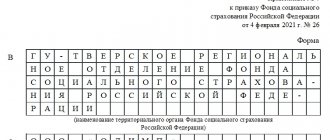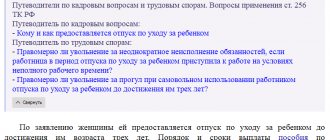Home/Vacation/Maternity/Going to work
Maternity leave is long. Therefore, exit after it must be issued in accordance with established rules. Today there is a special procedure for the actions that a maternity leaver must perform. The rules for carrying out manipulations are enshrined in the Labor Code of the Russian Federation. It is on this basis that you need to go to work.
Attention
It can be difficult to take into account all the nuances of maternity leave on your own. Therefore, experts advise familiarizing yourself with current information on the topic before carrying out the procedure.
Labor Code of the Russian Federation
The specifics of returning to work after maternity leave are regulated by the Labor Code of the Russian Federation. As a general rule, an employee must provide the employer with only a certificate of temporary incapacity for work. The document can be obtained from the antenatal clinic.
Then the employee is required to write a statement in free form. Based on it, the HR department issues an order. The document is provided to the employee against signature. If the procedure took place in this order, the woman will not need to provide any additional documents in order to start working again after maternity leave. When the period specified in the order ends, the employee will simply have to return to her duties.
IMPORTANT
According to Article 256 of the Labor Code of the Russian Federation, an employer does not have the right to dismiss an employee who is not working in connection with the birth of a child. During the absence of a maternity leave person, another person can be hired in her place, but only temporarily. When the new mother goes to work, the person occupying the position must vacate the position on the same day.
In addition to the Labor Code, the rights and obligations of the employer and employee are regulated by the following legal acts:
- Federal Law No. 81 of May 19, 1995.
- Federal Law No. 21 of February 25, 2011.
- Federal Law No. 255 of December 29, 2006.
- Order of the Ministry of Social Development of the Russian Federation No. 1012n dated December 23, 2009.
Experts advise you to first familiarize yourself with the provisions of the above standards.
How to provide standard deductions for personal income tax?
Tax residents of the Russian Federation (persons whose income is subject to personal income tax at a rate of 13%) are entitled to standard tax deductions for children. Deductions are provided by the tax agent or (if the tax agent did not provide deductions) the taxpayer can receive them by submitting a return to the tax office at the end of the year.
An application for personal income tax deductions is submitted in any form: “please provide me with standard deductions for children.”
To the application, the employee must attach the child’s birth certificate and other documents that may affect the amount of the deduction (for example: a certificate of disability of the child).
Deductions are provided in the following amounts:
- 1,400 rub. per month - for the first child;
- 1,400 rub. per month - for the second child;
- 3,000 rub. per month - for the third and each subsequent child;
- 3,000 rub. per month - for each disabled child under 18 years of age;
- 3,000 rub. per month - for each disabled child of group I or II under the age of 24, if the child is a full-time student (student, graduate student, resident, intern).
The standard deductions provided for disabled children are provided regardless of the disability status of the child.
A single parent is entitled to a double deduction. In this case, the parent is recognized as the only one (do not confuse with “lonely”) if:
- second parent died;
- the second parent is recognized by the court as missing or deceased;
- the father is not indicated on the child’s birth certificate;
- The paternity of the child has not been legally established.
Double deductions can be provided to one of the parents if the other refuses to make deductions.
Deductions are provided until the income, calculated on an accrual basis from the beginning of the year, reaches a value of 280,000 rubles.
If a woman goes to work in the middle of the year, the question arises of how to provide her with deductions for the child - from the month she went to work or by summing up previously unreceived deductions due to the lack of income subject to personal income tax.
Paragraph 1 of Article 218 of the Tax Code of the Russian Federation states that a standard deduction is provided for each month of the tax period. Therefore, it can also be provided for those months in which the employee had no income. In this case, standard deductions accumulate and the right to deduction can be exercised in the next month of the current tax period (before the end of the calendar year). Thus, if an employee went to work, for example, in April, she has the right to deductions for January-April and then for each month until her income from the beginning of the year, calculated on an accrual basis, does not exceed 280,000 rubles.
This corresponds to the explanations set out in the letter of the Federal Tax Service of Russia dated February 11, 2005 No. 04-2-02/ [email protected]
Letter of the Ministry of Finance of Russia dated October 7, 2004 No. 03-05-01-04/41 contradicts the above, referring to Articles 218 - 221 of the Tax Code of the Russian Federation.
Therefore, the tax agent has the right to choose an official letter that is beneficial to him and follow it, since the explanations of both departments exempt from tax liability in accordance with Article 111 of the Tax Code of the Russian Federation.
Therefore, the 1C: Salary and Personnel Management 8 program includes the ability to manage the procedure for providing standard deductions when calculating income tax (Fig. 6).
Rice. 6
The accounting policy for personal income tax is determined in Setting up accounting parameters on the personal income tax tab. There are two accounting policy options:
- standard deductions are applied on an accrual basis during the tax period - in this case, the deductions to which the taxpayer (employee) is entitled from the beginning of the year to the month of tax calculation are applied to the tax base calculated on an accrual basis for the year (the option corresponds to the provisions of the letter of the Federal Tax Service of Russia dated 11.02 .2005 No. 04-2-02/ [email protected] );
- standard deductions are applied within the limits of the taxpayer’s monthly income - in this case, the deductions to which the taxpayer (employee) is entitled in each month of the tax period are applied to the tax base calculated for this month (the option corresponds to the provisions of the letter of the Ministry of Finance of Russia dated October 7, 2004 No. 03 -05-01-04/41).
It is allowed to change the tax policy of the current tax period during the year, after which, when calculating personal income tax for the next month of the tax period, the amounts of deductions provided, as well as the tax amounts for previous months, will be recalculated.
Let us remind you that the right to a personal income tax deduction for a child remains, even if the child is not registered with his parents.
The deduction is due to parents if the child is supported by them (subclause 4, clause 1, article 218 of the Tax Code of the Russian Federation).
Parents are obliged to support their minor children regardless of their place of registration (Article 80 of the RF IC).
Therefore, the right to a deduction also does not depend on the place of registration of the child.
A similar point of view is expressed in the letter of the Ministry of Finance of Russia dated May 11, 2012 No. 03-04-05/8-629.
How long can I go back after maternity leave?
The duration of maternity leave is strictly defined. It is recorded in the order. When the period ends, the employee is obliged to continue working. Exceeding the established period of maternity leave is strictly prohibited.
In a number of situations, an employee has the right to resume work before the deadline. The current legislation does not prohibit this if the termination of the vacation is initiated by the employee herself. The girl is obliged to notify the employer of her desire. An application is drawn up for this purpose. Actions must be completed 4 days before the expected exit. This period is set so that the employer has time to calculate and dismiss the employee who temporarily held the position.
Order to leave after maternity leave
If a girl decides to go to work early, the employer will have to issue an appropriate order to leave after maternity leave. It is issued on the basis of an application received from the employee. There is no special sample on the basis of which an order is issued. However, the document must contain mandatory information. The employer is obliged to reflect the following data in the order:
- link to the application;
- date of return to work;
- information about the last day of maternity leave;
- order to terminate the provision of benefits.
The order must be given to the employee for review. To confirm the fact that the girl agrees with the provisions of the document, she leaves a signature on it. A sample of a completed order can be downloaded here.
What documents are needed?
The list of required papers directly depends on the time frame for leaving maternity leave. If the woman returns to work in accordance with the original order, no additional documentation is required. If the period of child care is terminated early, an application must be drawn up and a new order must be issued. The last document records the date the employee resumes her work activity.
Application for return to work after maternity leave
To leave maternity leave early, you will need to fill out an application. It is drawn up in free form. The law does not fix the specifics of drawing up documents. When filling out the paper, the employee must indicate the date of return to work and reflect in it a request to interrupt maternity leave and stop paying benefits. Additionally, the document can record the last date of the maternity leave. The application must be dated and signed by the employee. Experts advise discussing in advance with the employer the expected moment of returning to work. To avoid misunderstandings, it is recommended to prepare the application in 2 copies.
Step-by-step instructions for leaving maternity leave
The procedure for returning to work after maternity leave is not complicated. In the classic situation, there is no need to prepare additional documents. It is enough to simply show up at the workplace on time and resume activities. Exiting maternity leave early is a more complicated procedure. The girl will need to do the following:
- Visit the employer and fill out an application. The document is drawn up in free form. It records information about the planned release date and a request to interrupt the maternity leave. The application contains the date of its preparation and the signature of the employee. It is necessary to notify the employer of early termination of maternity leave at least 4 days before the expected date of return to work.
- Wait until the employer reviews the application and issues an order. It will reflect the girl’s date of return to work, and will also contain a link to her application. The order is provided to the employee against signature.
- Return to work on time.
Attention
It is not possible to resume activities ahead of schedule using any other scheme.
What to do if it is impossible to provide the previous job?
While on maternity leave, the woman retains her place of work and position (Articles 114, 256 of the Labor Code of the Russian Federation). Therefore, after leaving leave, the employee must return to the same position from which she went on leave.
If the previous job is not provided to her, we are talking about downtime due to the fault of the employer. Downtime caused by the employer's fault should be paid in an amount no less than 2/3 of the employee's average earnings (Part 1 of Article 157 of the Labor Code of the Russian Federation). Late payment may incur interest, just like any other late payment of wages.
If an employee is simply not present at the workplace due to her own fault during paid downtime, the downtime period may not be paid. Of course, we are talking about a situation where an employee can come to work, but does not. In cases where an employee is not present at the workplace due to the fact that she does not have a pass, and she is not allowed into the office, we are talking about deprivation of the opportunity to work and the employee can obtain payment through the court.
It happens that an employee herself does not mind moving to another job after maternity leave. For example, to another office of the same organization, if it is located closer to her home, or to a job that provides a smaller range of duties and responsibilities, if she is not confident in her abilities.
In this case, the question arises of how to arrange the transfer - after the employee returns from maternity leave or during the vacation period.
There are no restrictions on transfers after leaving vacation. In this case, the legal requirements will be met. After maternity leave, the employee will return to her previous job, and then the transfer will be formalized by agreement of the parties to the employment contract.
However, this option is not always suitable for the employer. Especially if before the maternity leave the employee was a financially responsible person. In this case, even with a short-term return to work that involves full financial responsibility (for example, as a cashier), we can talk about a change in the financially responsible person, which requires mandatory inventory.
Therefore, quite often practitioners are faced with the question: is it possible to arrange a transfer to another job during maternity leave (most often we are talking about parental leave).
Current labor legislation does not establish any restrictions on a transfer to another job by agreement between the employee and the employer, executed during the period of absence of the employee from work, including during maternity leave.
Therefore, such a translation is possible.
You can perform such a personnel transfer in the 1C: Salaries and Personnel Management 8 program. It is permissible to change the position and department of an employee. However, the amount of payment for the main accrual (for example, Salary) will not change, because it has been stopped for the period of vacation.
The only condition is that the transfer is allowed in the absence of contraindications for health reasons. If there are such contraindications, transfer to another job is impossible even with the consent of the employee (Part 4 of Article 72.1 of the Labor Code of the Russian Federation). In this case, we are talking, first of all, about employees with disabilities, since in other cases the employer may not have information about the presence of contraindications to work.
The absence of an employee from the workplace does not exempt the employer from complying with the transfer procedure provided for by law.
As a general rule, a transfer is possible only with the written consent of the employee (Article 72.1 of the Labor Code of the Russian Federation). It can be expressed by him in a statement addressed to the employer, which will contain a request for a transfer to another job. The employee can also indicate her consent as a handwritten note on the transfer offer received from the employer.
There is no need to interrupt maternity leave to complete the necessary documents.
The employee only needs to drive up to the employer’s office at a time convenient for her.
The employee's written consent to the transfer is not enough. A transfer is always associated with a change in the working conditions specified in the employment contract concluded between the employer and employee. Therefore, when completing a transfer, it is necessary to conclude an additional agreement to the employment contract.
Vacation immediately after maternity leave
According to the provisions of the Labor Code of the Russian Federation, a person has the right to apply for annual paid leave after 12 months of working activity. If the entire term has not been completed, rest may be granted in advance. This decision is made by the employer. A person can only take time off for the period that he managed to work. You will be able to go on vacation in a new place only after six months from the start of your activity.
A girl who was on maternity leave also has the right to leave on a general basis. Current legislation establishes benefits for women falling into this category:
- A girl has the right to go on annual paid leave immediately after maternity leave.
- You can take your annual holiday in advance.
- When choosing a time, a girl may not be guided by the general rest schedule of the enterprise.
- All required payments are provided in accordance with the norms of the Labor Code of the Russian Federation.
Maternity leave immediately after maternity leave
IMPORTANT
If a girl plans to go on another maternity leave after maternity leave, experts advise studying the current legislation in detail. The Labor Code does not contain a ban on such actions. Therefore, a woman has every right to go on maternity leave again. However, the employee may encounter problems when calculating payments. The fact is that you cannot receive maternity benefits and child care benefits at the same time. Therefore, a girl expecting 2 children will need to select the benefit that will be accrued.
You can return from maternity leave to maternity leave without actually visiting the workplace. However, experts advise carefully studying the current state of affairs in the company before taking advantage of such an opportunity. So, if wages in an organization have increased, it is possible to go back to work for a short period of time, and then leave again to care for the child. This allows you to count on an increase in the amount of benefits. In order for the employer to agree to provide repeated maternity leave, it is necessary to prepare a package of documents. The list must include:
- application for return to work and simultaneous resignation;
- sick leave confirming the right to carry out such an action;
- order to end the first decree;
- order to begin a new period of child care.
If a girl finds it difficult to draw up an application on her own, you can use a ready-made sample document.
Exiting parental leave: analyzing the situation
An employee has the right to interrupt parental leave at any time before the child reaches the age of three (hereinafter referred to as parental leave) and go back to work <*>. Let's look at situations that may arise in practice when leaving parental leave early, as well as at the end of this leave.
Situation 1. An employee decided to leave maternity leave early. Does she need to send a written statement to the employer about this?
Legislation allows an employee on care leave to interrupt it at any time and return to work <*>. An employee who has made such a decision only needs to notify the employer of her intention. It is advisable to do this in writing by submitting a corresponding application to the employer, although this is not required by law. The employee is not required to indicate in the application the reasons why she wants to leave maternity leave early, as well as the date on which she interrupts it. At the same time, it is necessary to indicate the date from which the employee plans to start work. The application will serve as the basis for issuing, for example, an order to return to work.
Situation 2. An employee who interrupted her care leave decided to resume it. What documents will be required in this case?
An employee who decides to resume maternity leave must write a corresponding application. It must indicate the date from which she resumes maternity leave.
In our opinion, the order in this case need not be issued. However, it will be needed if it is necessary to make an entry in the employee’s work book about being on maternity leave <*>. Then the order must indicate the date from which the employee uses the next part of her care leave.
Situation 3. The employee leaves maternity leave (early or at its end). What to do with an employee hired under a fixed-term employment contract during her absence?
The employee's return to work from care leave ahead of schedule or at its end is grounds for terminating the employment relationship with the employee with whom a fixed-term employment contract was concluded during her absence. Such an employee is subject to dismissal on the day preceding the day the employee goes to work <*>.
Example
The employee decided to interrupt her maternity leave and go back to work. On 09/07/2020, she brought the employer a corresponding statement, which indicated that she was going to start working on 09/09/2020. The employment contract with an employee hired during her absence terminates on 09/08/2020.
Dismissal occurs due to the expiration of the fixed-term employment contract under clause 2, part 2, art. 35 TK. Any category of employees can be dismissed on this basis.
Situation 4. An employee returns to work after interrupting her maternity leave and asks for part-time working hours. Does the employer have the right to refuse her? How to format this correctly?
At the request of a woman who has a child under the age of 14, the employer is obliged to establish a part-time or part-time working week for her with payment in proportion to the time worked <*>. In this case, the right to choose the type of part-time work belongs to the employee.
If an employee wishes to interrupt maternity leave and begin working part-time, she must submit a corresponding written application to the employer.
| An example of the wording of an application for early exit from parental leave on a part-time basis: “I ask that you allow me to work from 09/01/2020, interrupting my child care leave until he reaches the age of three years, and establish part-time work in the form of a reduction in working hours day from 8 to 4 o’clock (the start time of the working day is 08:00, the end time of the working day is 12:30, the break time for rest and food is from 10:00 to 10:30). |
The transition to part-time work during the period of employment is formalized by order (instruction) <*>. In this case, the basis for its publication will be the statement of the employee.
| An example of the wording of an order for early exit from care leave on a part-time basis: “I ORDER: 1. KOT Inna Ivanovna, legal adviser of the legal department, to interrupt maternity leave before the child reaches the age of three years at her request. 2. KOT Inna Ivanovna will start work on 09/01/2020. 3. KOT Inna Ivanovna establish part-time working hours (duration of the working day - 4 hours, starting time of the working day - 08:00, ending time of the working day - 12:30, break time for rest and food - from 10:00 to 10:30 ) with payment in proportion to the time worked.” |
The legislation does not contain requirements to make appropriate changes to the employment contract when part-time work is established during the period of employment <*>. At the same time, we believe that this should be done by concluding an additional agreement to the employment contract with the employee <*>.
Note! The employer is obliged to establish part-time working hours also at the request of an employee who has started work after the end of nursing leave <*>.
Situation 5. The employee returned to her previous place of work, interrupting her maternity leave. Some time later, she received notice that her contract was expiring, but her employer did not intend to renew it. Is the employer right?
Regardless of his wishes, the employer is obliged to extend the term of the contract with the employee who started work before the end of the care leave, with her consent, for a period of no less than until the child reaches the age of five years <*>.
Note! With an employee on nursing leave, with her consent, the employer must extend the contract for a period of no less than until the end of the nursing leave <*>.
Situation 6. An employee wants to work without interrupting her maternity leave. Is it possible?
An employee, while remaining on care leave, can work part-time (no more than half the monthly working time) <*>:
- at the main place of work, but in a different profession of a worker (employee position);
- to another (new) place of work.
In other words, without interrupting care leave, an employee can work on an internal or external part-time basis. In this case, she will receive the benefit in full <*>. If, for example, the employee returns to her previous job on a part-time basis, then the care leave will be interrupted <*>.
Situation 7. An employee plans to return to work after finishing her maternity leave. How to determine the day on which she should start work?
While on nursing leave, the employee is assigned and paid benefits. Its payment is made monthly until the day the child reaches the age of three years inclusive <*>. From this we can conclude that the last day of parental leave is the day the child turns three years old. The employee must go to work on the next working day after this day.
Example
The child turns three years old on September 1, 2020. This day is the last day of maternity leave. The mother of the child must go to work on September 2, 2020.
Situation 8. Maternity leave has ended and the employee returns to work. Is a statement from the employee and the issuance of an order required in this case?
If the period of maternity leave for up to 3 years has expired, then, like at the end of any other leave, the employee begins work without submitting an application. In this case, it is not necessary to issue a corresponding order. After all, due to the end of care leave, the employee is obliged to start work on the next working day after the child turns three years old. However, an order must be issued if it is necessary to make an entry in the employee’s work book about the period of her being on nursing leave <*>.
Situation 9. The employee returned to work after the end of her maternity leave. How to calculate her working year for the purposes of providing leave?
The legislation determines the periods included in the working year for which labor leave is granted <*>. The time of maternity leave does not apply to such periods, i.e. <*> is not included in the working year. If there are periods during the working year that are not included in the working year, then its duration becomes less than 12 full months. And then the working year is shifted by the missing time <*>.
| An example of calculating the working year of an employee who has returned from maternity leave The start date of the employee’s working year is 02/03/2017. From May 27, 2017 to September 29, 2017, she was on maternity leave. From 09/30/2017 to 08/03/2020 - on maternity leave. I went back to work on 08/04/2020. Let's determine the working year of the employee. The period of the working year from its start date to the provision of care leave is 239 calendar days (hereinafter referred to as k.d.), where: working hours from 02/03/2017 to 05/26/2017 - 113 k.d.; maternity leave from 05/27/2017 to 09/29/2017 - 126 k.d. From the date she starts working until the full working year, she needs to work another 126 k.d. (365 - 239). In this case, 365 k.d. is accepted for calculation, because if the working year had not shifted, then the employee would have worked 365 days from 02/03/2017 to 02/02/2018. To the date of departure from care leave (08/04/2020) we add the missing 126 k.d. In this case, the day of release is taken into account when calculating. The last day of the working year is 12/07/2020. So, the working year of the employee is from 02/03/2017 to 12/07/2020. |
There is no need to issue an order to remove a working year employee, but this is not prohibited by law.
Read this material in ilex >>*
* following the link you will be taken to the paid content of the ilex service
Exiting early after maternity leave
A girl can independently decide when to go to work. The law does not prohibit returning to work early. If a woman has made such a decision, she must inform the employer about the planned day of release. To do this you will need to fill out an application. It is drawn up in free form. The document must record the date when the girl plans to go to work. The application must be submitted at least 4 days before returning to work. This period is given to the employer to make a settlement and dismiss the employee who replaced the girl.
For your information
Having received the application, the employer will draw up an order based on it. The document will reflect the deadline for the woman to return to her work duties, and will also contain a link to the employee’s application. The girl must be familiar with the completed order. The document is provided to the employee against signature.
When all formalities are completed, the girl can return to her duties. Actions must be carried out on the day that appears in the order. Violation of the established deadline may result in sanctions.
Part-time work after maternity leave
A young mother has the right to work part-time or perform her duties at home. This right is fixed in Article 256 of the Labor Code of the Russian Federation. If a girl wishes to work part-time, she must contact her employer and inform her of her desire. To record the changes, an additional agreement to the employment contract will be drawn up. The document will reflect the following information:
- length of the working day and working week;
- rest order;
- salary amount.
Additional information
The payment for performing work duties in this situation will also change. An employer can provide payment in two ways - for the number of hours worked or for the amount of work performed. The choice is made depending on the individual characteristics of the current situation.
WE TEMPORARILY TRANSFER ANOTHER EMPLOYEE
If management decides to involve an employee of their organization in performing the labor function of a “maternity maid” without inviting an outsider, then in such cases his temporary transfer should be arranged.
Let us pay attention to the points that are important when registering the transfer of an employee to a “maternity” position.
According to Art. 72.2 of the Labor Code of the Russian Federation, by agreement of the parties, concluded in writing, an employee may be transferred to another job to replace a temporarily absent employee temporarily - until this employee returns to work.
For such a transfer, an additional agreement is drawn up. The wording in it, for example, could be like this:
The parties to the employment contract dated January 1, 2017 No. 1 agreed on the following. 1. The employee is transferred to the position of sales manager temporarily, for the period of temporary absence of A. N. Mankova. 2. The employee is given a salary of 20,000 rubles. per month. 3. Other terms of the employment contract remain unchanged.
Based on this additional agreement, an order is issued to temporarily transfer the employee to another job.
There is no need to make an entry in the work book, since according to Art. 66 of the Labor Code of the Russian Federation, an entry about a temporary transfer of an employee is not made in the work book (unlike a permanent transfer).
Actions in case of refusal to provide a workplace
According to the provisions of the Labor Code of the Russian Federation, a girl has the right to apply for the same position that she held before maternity leave. In practice, this rule is not always observed. Employers are often reluctant to take a woman and her child back after maternity leave. The fact is that children often get sick. This will lead to the fact that the woman will be forced to often be on sick leave. In addition, employees with small children cannot devote themselves entirely to work. Maternity leave is a long period. During this time, significant personnel changes may occur in the company.
Regardless of the existing reasons, the employer is obliged to take the girl back to her previous place after maternity leave. If such an action is refused, it is considered illegal. In this situation, a woman whose rights have been violated has the right to file a complaint with the labor inspectorate. Their representatives will hold the employer accountable. Experts do not recommend writing a statement of your own free will in this situation. If an employee leaves on her own, she will not be able to claim benefits.
WE FIRED A TEMPORARY WORKER
If instead of a “maternity leaver” an employee worked under a fixed-term employment contract, then with her release the time comes to terminate such an employment contract. According to Part 3 of Art. 79 of the Labor Code of the Russian Federation, the departure of the main employee is an unconditional basis for the dismissal of a temporary employee who worked in his place.
Practice suggests taking into account some features of the dismissal procedure in this case.
As a general rule, three calendar days before the termination of a fixed-term employment contract, the employer must notify the employee of the termination of the contract (Article 79 of the Labor Code of the Russian Federation). However, for the case we are considering, the Labor Code of the Russian Federation makes an exception and does not oblige the employer to take this step.
Therefore, the personnel service must immediately begin processing the dismissal of a temporary employee.
If a temporary worker is pregnant
The situation becomes more complicated if the employee who needs to be fired happens to be pregnant. As a general rule, if the term of the employment contract expires during the employee’s pregnancy, the employer is obliged, at the request of the woman, to extend the term of the employment contract until the end of maternity leave.
But the situation with a pregnant employee on maternity leave when the main employee leaves is an exception to the rule (Part 3 of Article 261 of the Labor Code of the Russian Federation). Her dismissal is allowed without extending the term of the contract if it is impossible to transfer her to another job available to the employer (either a vacant position or work corresponding to the woman’s qualifications, or a vacant lower position or lower-paid job), which the woman can perform taking into account her state of health.
Thus, if the organization has a vacant position that fits the above description, then the employee must be offered it - in writing and against signature.
If the employee agreed to the transfer, it is necessary to draw up an additional agreement to the employment contract and an order for the transfer. At the same time, the employment contract with her must be extended until the end of the pregnancy (Part 2 of Article 261 of the Labor Code of the Russian Federation)[3].
If there are no vacant positions, in our opinion, it would be a good idea to notify the woman about this in order to avoid disputes in the future.
So, if the employee refuses the transfer or the organization does not have suitable vacant positions for her, an order should be issued to dismiss the temporary employee.
On the same day, it is necessary to draw up all personnel documents and perform actions related to the dismissal, including issuing her a work book and making payments.
If the employee is absent from work (vacation, illness), the employer nevertheless has the right to dismiss her, since the expiration of the employment contract does not constitute dismissal at the initiative of the employer.
Actions in case of impossibility to return from maternity leave
A woman can be on maternity leave until the child reaches 3 years of age. The period cannot be extended beyond this period. If a girl cannot go to work within the established period, she must justify a similar reason. All established facts will need to be documented. If the circumstances are not justified, dismissal will be required. It is carried out in the general order. The girl will have to submit a letter of resignation of her own free will. After a two-week period, the woman will be able to receive a work book and payment.
WE HIRE AN EMPLOYEE UNDER A FIXED-TERM EMPLOYMENT CONTRACT
This is the most common option for temporarily replacing an absent employee. Let's consider what you need to pay attention to when preparing personnel documents in order to avoid unnecessary legal risks.
Part 1 art. 59 of the Labor Code of the Russian Federation allows you to conclude a fixed-term employment contract for the duration of the duties of an absent employee, who retains his place of work. According to Part 2 of Art. 57 of the Labor Code of the Russian Federation, in a fixed-term employment contract, it is necessary to indicate the duration of its validity and the reason for its urgency. Moreover, in this case, the deadline and the reason coincide - this is the absence of the main employee.
The wording in an employment contract, for example, could be as follows:
1.3. The employment contract was concluded for the period of absence of A. N. Mankova.
The employment order must also indicate the urgency of the work.
An entry about employment in the work book is made without indicating the fixed-term nature of the contract.









